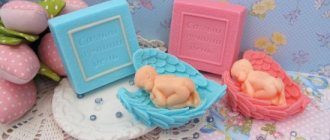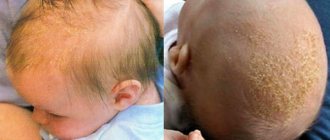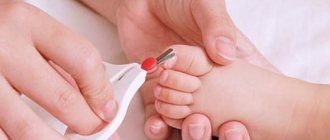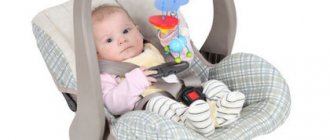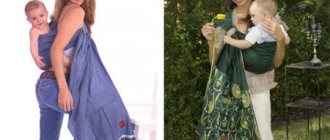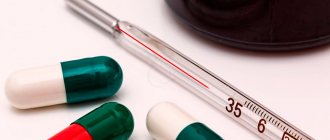In the first days/weeks of life, a newborn is very vulnerable to infections that can enter through the umbilical cord.
In such cases, you need to properly treat the baby’s navel with an antiseptic. You can use hydrogen peroxide for this. For young parents, caring for a baby is an extremely important period, and it is the umbilical cord that requires special attention. The baby's navel is a wound, and through unhealed tissue, a pathogenic infection can easily enter the child's body.
How can you treat your navel?
The most dangerous pathologies for a newborn due to improper care of the navel are staphylococcus, sepsis (blood poisoning) and omphalitis. It is extremely difficult to deal with such complications. In order for the baby to have good health, it is necessary to organize proper wound care. Among the most common antiseptic and disinfectants for treating the navel are:
- 3% hydrogen peroxide;
- brilliant green (zelyonka);
- potassium permanganate (potassium permanganate);
- chlorophyllipt.
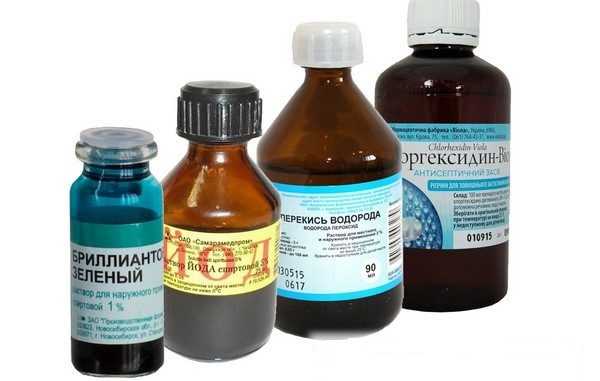
It should be noted that these drugs are a powerful antiseptic, so they must be used strictly as directed, taking precautions, otherwise the child may suffer a skin burn or purulent ulcers in the navel area.
How to properly store the powder and already prepared composition
One of the properties of potassium permanganate is strong oxidation. Crystals should be stored in a dark and dry place, in a jar with a tight-fitting lid. The powder diluted in liquid is placed in a dark place where natural light does not reach.
The salts contained in manganese disintegrate under the influence of sunlight, and the substance loses its beneficial properties and becomes unsuitable for treating the navel. A highly concentrated solution can be stored for no more than 7 days, and a weak solution can be stored for a maximum of 10 hours.
Treatment of the navel with peroxide solution
When the baby is born, the umbilical cord is clamped closer to the tummy with a special clamp (clothespin) and cut off, leaving a small stump (tail-knot). From birth until the moment of mummification of this piece of umbilical cord, approximately 4-5 days pass, after which an umbilical wound is formed, which is a cause for concern. But with proper treatment, it heals after 2-4 weeks.
When treating a newborn's navel at home, it is important for parents to follow the rules of personal hygiene, because... there is a risk of a pathogenic infection entering the wound. To prevent infection, you should handle your baby with clean hands.
Treatment of a baby's navel with hydrogen peroxide is required for the following reasons:
- destroys harmful bacteria, infections, viruses and other pathogenic microorganisms;
- prevents inflammation;
- promotes drying and rapid healing;
- neutralizes the secretion of ichor;
- softens the crusts.
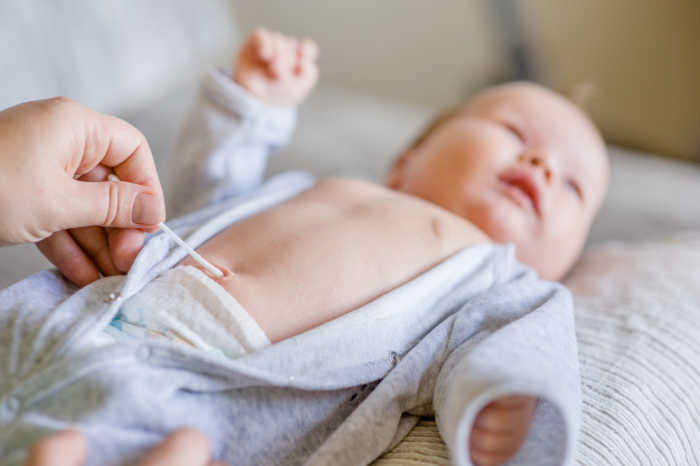
To clean the baby's navel, use cotton swabs, cotton pads, bandage swabs, and a sterile pipette. It is worth understanding that pathogenic bacteria can accumulate under the crusts, which will lead to infection and inflammation of the umbilical cord wound. Therefore, ignoring the antibacterial drug is dangerous for the baby’s health.
Treatment of the navel until the “tail” falls off
The remainder of the umbilical cord with a clothespin should be processed as follows:
- In the morning and evening, drop 1-2 drops of 3% peroxide into the navel with a pipette, be sure to wipe around its borders with a cotton pad.
- Gently move the umbilical ring with your fingers so that the antiseptic gets into the internal folds and washes out all the discharge.
- Wait until the peroxide stops fizzing (20-30 seconds).
- Remove softened crusts from around the umbilical cord.
- After cleaning the umbilical ring, the area under the clothespin is lubricated with an antibacterial agent (brilliant or chlorophyllipt).
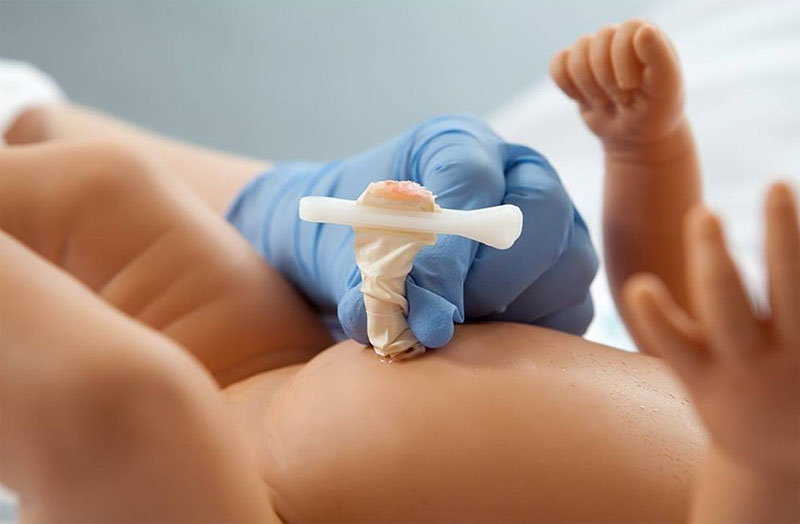
There is no need to be afraid to touch the clamp during the procedure - the main thing is not to pull or rotate it to the sides. At a certain point, the stump with the bracket will easily fall off on its own and the baby will not even feel any discomfort.
Treatment of the navel after the stump falls off
It is recommended to care for the umbilical cord wound after the remainder of the umbilical cord falls off in the morning after waking up and feeding, and in the evening after bathing, when the baby is in a calm mood. As a rule, treating the navel with hydrogen peroxide includes several successive steps:
- Wash your hands with antibacterial soap.
- Use your fingers to open the navel and drop a solution of 3% hydrogen peroxide from the pipette. It is worth considering that the peroxide solution should not be cold - before instillation, hold the pipette with liquid in your hand for a couple of minutes.
- Wait until foaming stops.
- The softened crusts are separated from the wound with a cotton swab.
- Next, dry the baby's navel well, dabbing it with cotton pads or a swab made from a bandage folded several times.
- Spread the edges of the navel again and apply hydrogen peroxide again with a cotton swab.
After the procedure, you should absolutely not cover the umbilical wound with a bandage, as this will lead to accumulation of moisture and can cause inflammation.
Rules for processing the umbilical cord in a child
Important!
If after 4 weeks of treatment the wound has not healed, although care was carried out correctly, it is recommended to contact your pediatrician. If the skin around the navel becomes red, swelling or purulent discharge appears, consult a doctor immediately!
Important Rules
If mom and dad, following the recommendations of Dr. Komarovsky, have excluded the child from fully bathing until the umbilical wound has completely healed, then they wipe the body daily with a damp cloth or napkins.
When taking an active position in the issue of bathing a newborn, parents must adhere to the main rule: immersion in water is allowed only if the navel heals normally, without complications.
This is interesting. The use of clothespins (clamps) in maternity hospitals began relatively recently; before that, the umbilical cord was tied with cloth or silk thread. A clothespin is a plastic product 3–6 cm long that secures the remaining end of the umbilical cord.
Very often the umbilical cord remnant may bleed. This is a completely natural stage of the formation of a blood crust. You can bathe a baby in this situation, but with extreme caution, without touching the clothespin.
If the navel bleeds constantly, even after it has been treated with antiseptics and two weeks have already passed since the birth of the baby, you should consult a pediatrician. The umbilical wound can become clogged for several reasons (improper treatment, blood diseases in the child, fragile blood vessels), and a doctor must understand them.
Important! Under no circumstances should you unscrew or remove the clothespin yourself, even if it has practically fallen off (or, conversely, does not fall off for a long time). Such actions can lead to severe bleeding.
Sometimes the clothespin may fall off on its own while swimming. In this case, there is no need to panic. You should, as usual, carry out the treatment and in the following days observe how the umbilical wound heals.
To avoid damaging your baby's delicate skin, most doctors do not recommend adding potassium permanganate to your newborn's bath water. If the required concentration is exceeded, the potassium permanganate solution can be harmful.
Contact with undissolved crystals of the substance leads to burns. When using herbal infusions, you also need to be vigilant and monitor skin reactions. If allergic manifestations begin, no more herbs are added.
Treatment of the navel with hydrogen peroxide and brilliant green
Of all the antibacterial baby care products, treating the navel with hydrogen peroxide and brilliant green is the most popular procedure. The navel is located close to the child’s vital organs, and if wound healing does not proceed well, dangerous complications may develop that require antibiotic therapy or hospitalization. In the first days of a newborn’s life, bloody discharge from the navel is possible, so the umbilical wound should not be allowed to become infected.
In principle, the algorithm for disinfecting a baby’s navel is the same as in the previous instructions:
- 2 times a day.
- Clean hands.
- Pipette and instillation of the navel.
- Gently clean the navel of crusts.
- Dry the wound with a cotton pad.
- Apply brilliant green with a cotton swab.
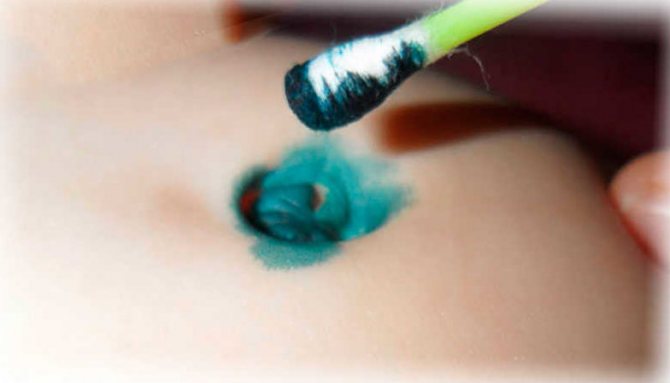
It is necessary to treat the wound directly with brilliant green (that is, there is no need to lubricate the skin around it). An important nuance: brilliant green does not need to be “smeared” in the literal sense, but applied with blotting movements from the center to the edges. Daily treatments speed up healing, since this product disinfects and dries well.
Although brilliant green is an alcohol-based antiseptic, it acts more mildly than iodine and is therefore safe for external use. The main disadvantage is the persistent staining of the skin, which is why it is often replaced with a modern drug - chlorophyllipt.
Helpful advice
Pediatricians recommend bathing newborns in water with potassium permanganate, which disinfects the water and prevents infections of the umbilical wound. To disinfect the water, just a pinch on the baby bath is enough to turn the water a little pink. After such a bath, be sure to apply post-bath lotion to the baby’s skin, because... potassium permanganate can dry out delicate skin.
FAQ
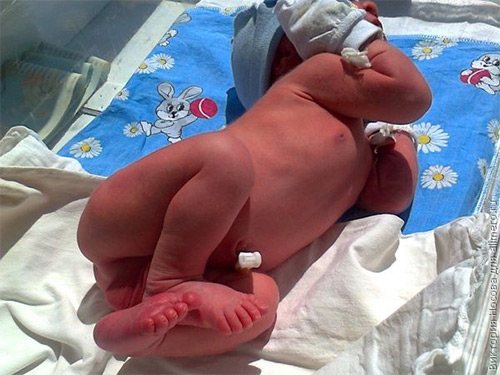
Readers of Ogrudnichke.ru recommend: - Review of the most popular vitamin supplements for children from Garden of Life Read the article >>> - How can Earth Mama products help young parents care for their infants? Read the article - Dong Quai is an amazing plant that helps maintain youth in the female body Read more... - Vitamin complexes, probiotics, omega-3 from Garden of Life, designed specifically for pregnant women Find out more >>>
Is it possible to use ointments for quick healing?
It is not advisable to use ointments, as they contribute to the formation of granular tissue. Doctors recommend using Baneocin in powder form. But you should use it for more than a week, as it can cause an allergic reaction, skin rashes, itching and redness. Long-term use can cause hearing loss.
What causes an umbilical fistula?
They are formed due to inflammation in the abdomen. In particularly advanced cases, feces and urine may be released from the fistula.
What are the dangers of pathogenic microorganisms getting into the umbilical wound?
Escherichia coli streptococci and staphylococci can cause omphalitis. Therefore, it is worth diluting potassium permanganate and periodically treating the child’s navel.
How else can you treat the umbilical cord?
When treating the umbilical cord, brilliant green, an alcohol solution of chlorophyllipt and baneocin are used.
Data. Model Karolina Kurkova does not have a belly button. This happened due to the removal of an umbilical hernia. Alfred Hitchcock has the same feature of the body.
Hygiene rules for an unhealed navel

Children's clothes need to be additionally disinfected with an iron.
Bathing is one of the important stages in care. However, there are some other recommendations you should follow.
- Keep children's clothes clean. It is advisable to change it up to two times a day or more often if the umbilical wound gets wet. Additionally, you need to disinfect your underwear with an iron.
- Children under one year old need clothes made from natural fabrics. Very often, synthetic materials become a source of infection or allergy. An undershirt made of linen and cotton is ideal for the first days of life.
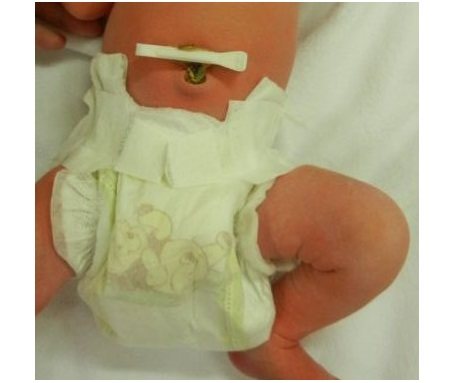
The diaper should not touch the navel - After bathing, the navel must be carefully blotted. If possible, it is worth removing as much moisture as possible in order to carry out proper treatment with antiseptic agents.
- Carry out hardening and air baths. It is enough to leave the baby naked for 15 minutes every day, provided that the air temperature in the room allows this. The optimal limit is 24 degrees.
- When putting on a diaper, you should turn down the top edge so that the navel does not come into contact with it. It is recommended to change the diaper every three hours, and do not wait until it is completely dirty.
Moisture is a source of proliferation for many bacteria, so any folds, including the baby’s navel, should always be dry and clean.
How to properly dilute permanganate
Most often, how to prepare potassium permanganate is discussed in antenatal clinics during lessons for expectant mothers. For those who have not visited them, we provide our tips and recommendations.
IMPORTANT! The solution must be fresh, just prepared. It cannot be reused. In addition, it must be strained so that no undissolved crystals remain.

